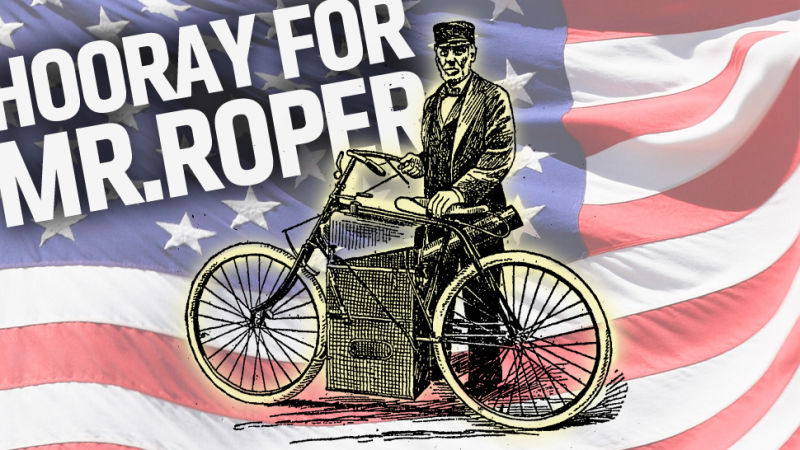
It’s almost Independence Day here in the U.S., and I’d like to ask you to take a moment from giving those Redcoats the finger and chugging Pabst to reflect on a true American hero, Sylvester Roper, inventor of both the motorcycle and dying on a motorcycle.
This post originally ran in July of 2013, and is being re-shared for the Fourth of July holiday.
Sylvester Roper was born in Boston in 1823, and proved himself to be a gifted mechanic and inventor from a very young age. When most kids of his era were pushing iron hoops down the road with sticks or boiling paraffin or telegraph-tweeting or whatever the hell kids did back then, Sylvester was building steam engines and inventing new types of sewing machines.
Advertisement
Eventually, Roper turned his attention to steam-powered vehicles, and while he wasn’t the earliest, he did have a working, drivable steam carriage as early as 1863. Just think about that for a moment. When our country was still in the middle of a war trying to decide if certain groups of people were property or not, this guy was out, driving around in a car.
It seems that being an incredible badass with a car 50 or so years before everyone else would catch on wasn’t enough for Roper, so he decided to start experimenting with two-wheeled steam vehicles, perhaps out of a desire to head to the California Territory where he could lane-split.
Sponsored
By 1867, Roper had built his first steam velocipede, and he was hooked. Built on what is likely a purpose-built frame (there’s some contention on that), Roper’s machine hung the boiler right below the rider’s junk (not a worry if you were Roper, who seemed to have balls made of the finest forged steel), with the twin pistons flanking the frame to either side. The water tank was saddle-shaped and used as a seat, and the wheels were solid iron. Oh, and true to its future progeny, there was a nice big steam pipe exiting behind the driver, hopefully chromed.
To operate the motorcycle, Roper came up with the twist-grip method we know and love today, though a bit different: the whole handlebar twisted as a unit, forward giving throttle, and backwards applying the not-too-effective spoon brake. It’s a pretty intuitive interface, if you think about it.
There was so much about this 328cc steam motorcycle that sets the template for the future: a pressure gauge right where we expect the instruments on a modern motorcycle, an engine-powered water pump, spring suspension of the drivetrain—it’s a truly ingenious machine.
I should mention that there’s some people who don’t consider Roper’s machine to be the first motorcycle because it wasn’t gas-powered. I say that’s inane. You put a motor between your legs on a bike frame, and that’s a motheradoring motorcycle, period. So shuddup, you.
Advertisement
From this beginning Roper kept developing, culminating in his safety-bike-framed version that he’d been refining from 1884 until he died on it in 1896. It was described at the time as being about 8 HP, and the whole assembly only weighed about 150 lbs, with coal and water, which is damned impressive.
Roper did many exhibitions and shows involving his carriage and motorcycle, and from all accounts seemed to genuinely enjoy riding the motorcycle. He died doing what he loved in 1896, when while riding on Boston’s Charles River bicycle track, he was hauling iron ass at 40 MPH, when his bike appeared to wobble, and then crash.
The cause of death was found to be a heart attack, though whether it was the cause or the effect of the loss of control isn’t really known. A Boston Globe obituary suggested that Roper had cut off the steam prior to crashing, indicating that he knew something was wrong.
We’ll never really know, and, in the end, it doesn’t matter. Sylvester Roper was one of those incredible combinations of brains and balls (or ovaries, as the case may be) that are the driving force behind so much of what’s good in the world.
So, raise your tepid beers to the sky and give some thanks to old Sylvester, the American hero.
(Sources: Wikipedia, The Vintagent)













